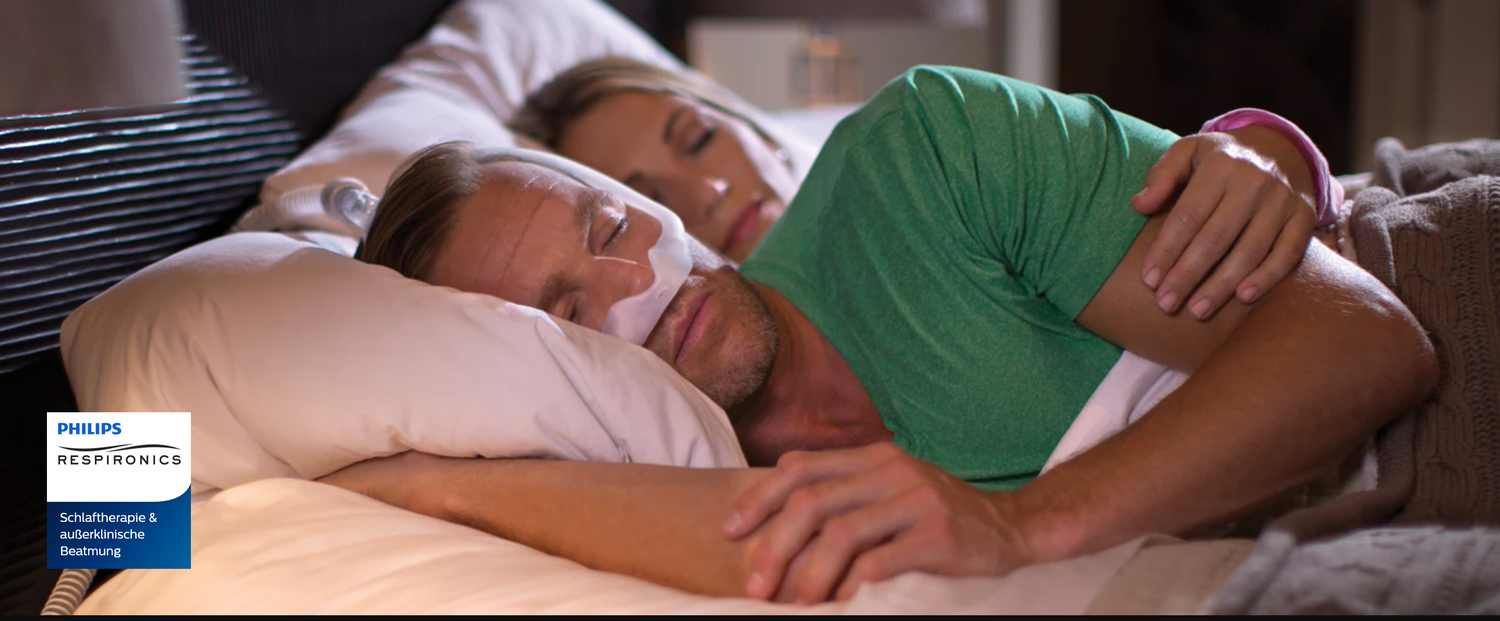
What is sleep apnea?
Teilen
What is Sleep Apnea?
Sleep apnea is a common sleep disorder characterized by repeated breathing interruptions during sleep.
These interruptions, also called apneas, are caused by the collapse of the upper airways, preventing oxygen from reaching the lungs.
Apneas can significantly affect your energy levels, mental performance, and long-term health. Do not ignore potentially dangerous symptoms such as snoring and excessive daytime sleepiness; instead, consult a sleep specialist. Treatment can help you get the sleep you need to feel like yourself every day.  Video: Sleep Study Play Video 02:57 The stay in the sleep lab is simple and painless.The resulting treatment can completely change your life. A sleep study takes place overnight in a sleep laboratory. Myth: Sleep Laboratory Myth: I don't think I can sleep well in a sleep laboratory. White line Fact: Although many people have this fear, most can sleep well in a sleep laboratory. By Teofilo Lee-Chiong, M.D., Chief Medical Interconnect, Philips Healthcare Solutions The diagnostic report on your sleep study Your doctor has ordered an overnight sleep study (also called "polysomnography" or abbreviated PSG) to be conducted in a sleep laboratory or at your home to clarify the suspicion of sleep apnea. Once the sleep study is completed, your doctor will share the results with you and discuss the next steps. You might receive a printout of your PSG report. When you read the report, you will likely find a lot of unfamiliar technical terms.The following example shows what is typically included in a diagnostic report of a sleep study. It also explains the technical terms used. Sleep Study Diagnostic Report Name: Müller, Max Height: 185 cm Test Date: 09.08.2012 Date of Birth: 21.01.1973 Weight: 93 kg Age: 39 years BMI: 27 Referring Physician: Dr. Acula Gender: male Test No.: 136 Mr. Müller is a 39-year-old male patient referred by Dr. Schmidt with symptoms of snoring and excessive daytime sleepiness. His partner reports that Mr. Müller experiences apnea episodes and wakes up several times at night with gasping. The patient is 185 cm tall and weighs 93 kg, with a BMI of 27.0. According to the Mallampati classification, his oral-pharyngeal space is classified as Grade 3. The medical history shows significant hypertension. The current medication includes Lisinopril and Prilosec. The patient usually goes to bed at 10:30 PM.To rule out the diagnosis of obstructive sleep apnea (OSA), a full diagnostic polysomnography in the laboratory was ordered." />
Video: Sleep Study Play Video 02:57 The stay in the sleep lab is simple and painless.The resulting treatment can completely change your life. A sleep study takes place overnight in a sleep laboratory. Myth: Sleep Laboratory Myth: I don't think I can sleep well in a sleep laboratory. White line Fact: Although many people have this fear, most can sleep well in a sleep laboratory. By Teofilo Lee-Chiong, M.D., Chief Medical Interconnect, Philips Healthcare Solutions The diagnostic report on your sleep study Your doctor has ordered an overnight sleep study (also called "polysomnography" or abbreviated PSG) to be conducted in a sleep laboratory or at your home to clarify the suspicion of sleep apnea. Once the sleep study is completed, your doctor will share the results with you and discuss the next steps. You might receive a printout of your PSG report. When you read the report, you will likely find a lot of unfamiliar technical terms.The following example shows what is typically included in a diagnostic report of a sleep study. It also explains the technical terms used. Sleep Study Diagnostic Report Name: Müller, Max Height: 185 cm Test Date: 09.08.2012 Date of Birth: 21.01.1973 Weight: 93 kg Age: 39 years BMI: 27 Referring Physician: Dr. Acula Gender: male Test No.: 136 Mr. Müller is a 39-year-old male patient referred by Dr. Schmidt with symptoms of snoring and excessive daytime sleepiness. His partner reports that Mr. Müller experiences apnea episodes and wakes up several times at night with gasping. The patient is 185 cm tall and weighs 93 kg, with a BMI of 27.0. According to the Mallampati classification, his oral-pharyngeal space is classified as Grade 3. The medical history shows significant hypertension. The current medication includes Lisinopril and Prilosec. The patient usually goes to bed at 10:30 PM.To rule out the diagnosis of obstructive sleep apnea (OSA), a full diagnostic polysomnography in the laboratory was ordered." />
Weak respiratory muscles, a large tongue, obesity, and other factors can cause the upper airways to collapse, obstructing breathing. About 10 % of the adult population worldwide suffers from sleep apnea, and approximately 90 % of them have not been diagnosed yet1.In the USA, at least one in five adults suffers from mild obstructive sleep apnea. This is alarming, as sleep apnea is a serious condition. Sleep apnea disrupts sleep and can significantly affect energy levels, mental performance, and long-term health. In some cases, sleep apnea can be fatal if left untreated. It can be challenging to take the first steps to determine if you suffer from sleep apnea. We are happy to assist you. You are not alone


